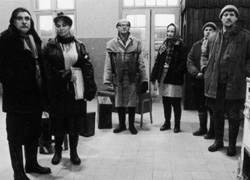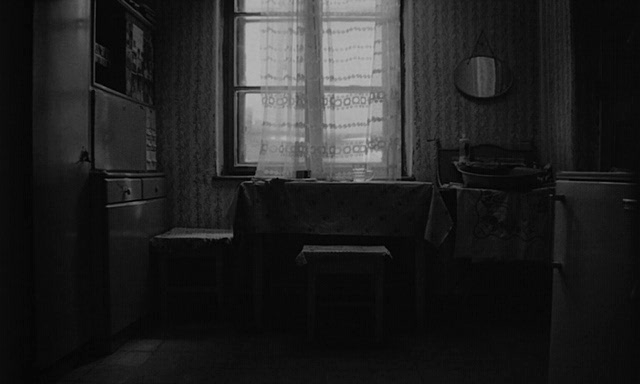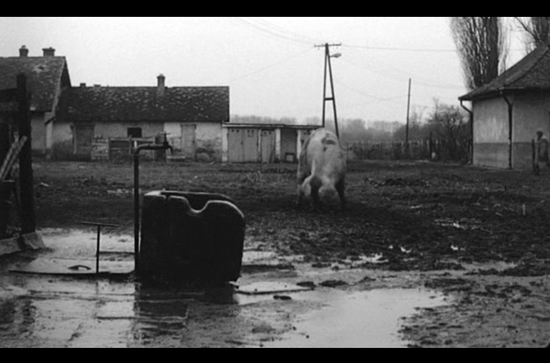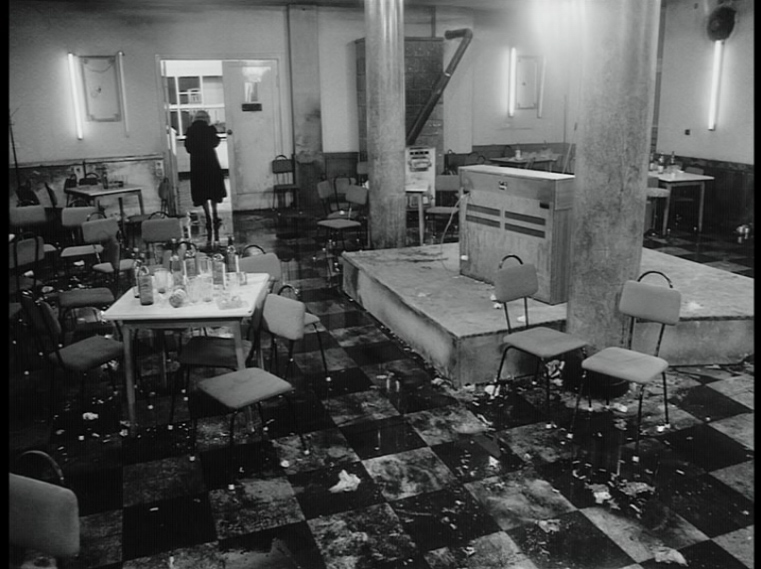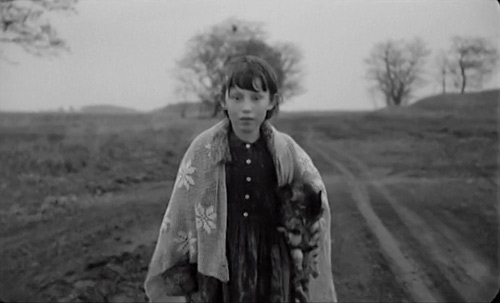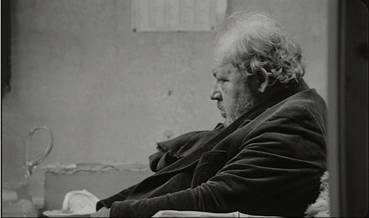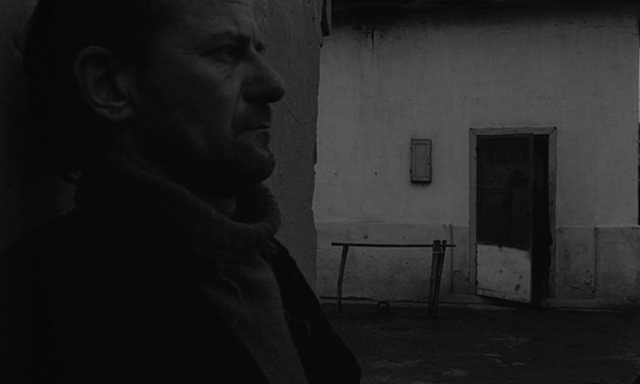From the Chicago Reader (October 14, 1994). — J.R.
**** SATANTANGO
(Masterpiece)
Directed by Bela Tarr
Written by Tarr and Laszlo Krasznahorkai
With Mihaly Vig, Putyi Horvath, Erika Bok, Peter Berling, Miklos B. Szekely, Laszlo Fe Lugossy, Eva Almasi Albert, Alfred Jaray, Erzsebet Gaal, Janos Derzsi, and Iren Szajki.
If great films invent their own rules, reinventing some of the standards of film criticism in the process, Bela Tarr’s Satantango surely belongs in their company. Showing Sunday as part of the Chicago Film Festival, this very dark Hungarian black comedy has more than a few tricks and paradoxes up its sleeve. Shot in black and white, with a running time of just under seven hours (it’s designed to be shown with two short intermissions), it boasts a decrepit, squalid rural setting enveloped in constant rain and mud and a cast of about a dozen greedy, small-minded characters, none of whom has any remotely redeeming qualities. Yet over two separate viewings it has provided me with more pleasure, excitement, and even hope than any other new picture I’ve seen this year.
I’m not the only one who feels this way. Since the film surfaced at the Berlin Film Festival in February and was enthusiastically heralded by J. Hoberman in the Village Voice, it has enjoyed successful runs in Hungary and Germany. (In Budapest, Tarr told me, some viewers were willing to stand for the whole seven hours.) It has already acquired distributors in Holland, Italy, and Switzerland, and tickets for the single screening at the New York Film Festival were sold out even before the ad appeared in the New York Times, at which point about 200 more orders came in.
On the other hand, at the second of two screenings held at the Toronto Film Festival last month, there were only a handful of people, though nearly all of them stayed to the end. Many of my colleagues writing for national publications admitted that they would rather risk seeing three or four bad films in a row than take a chance on this one. I suspect that part of what put them off is the chance they might really like it — which would interfere with their usual line of work. The very notion of a seven-hour masterpiece challenges the way the film business operates, especially in a climate where the value of a movie is largely gauged by the big-studio cash poured into its promotion. Satantango was shot over two years — 120 shooting days in all — at a cost of a little over a million and a half dollars, or roughly one-twelfth the cost of a “low-budget” Hollywood picture like Ed Wood. And we all know that, regardless of how good or important it is, its chances of being recognized in the national media are nonexistent.
Sarcastic to the core, this movie demands to be read as a kind of interim report on where humanity seems to be lodged — in a quagmire of cowardice, betrayal, self-delusion, alcoholism, and deceit, a place where people snoop on their neighbors and strive to cheat them behind their backs and where bureaucracy has become so encrusted in its own self-serving operations that buzzwords like communism, capitalism, and even Christianity have become meaningless, interchangeable labels for whatever grubby social and economic interactions happen to take place.
Yet I think it would be wrong to call this adaptation by Tarr and Laszlo Krasznahorkai, who wrote the celebrated 1985 Hungarian novel of the same title, misanthropic, at least in the sense that, say, Stanley Kubrick’s movies are. Like Luis Bunuel and perhaps the painter Pieter Brueghel, Tarr and Krasznahorkai have a view of abject, self-absorbed peasants that is too passionate and too richly human to be adequately described as cynical or antisocial. When a bunch of their characters are seen elaborately dismantling a large cabinet outdoors while preparing to move from a depleted farm to an abandoned manor house nearby, the revelation that they’re carrying this out to prevent “the Gypsies” from taking this useless piece of furniture is quintessentially Bunuelian in its comic — and cosmic — futility.
So far I could almost be describing a painting. But even though the action of Satantango covers only two consecutive fall days, followed by a couple of mordant epilogues occurring later the same month, this is a narrative constantly in motion — at least in the way we experience it — thanks to Tarr’s elaborately choreographed camera style and respect for duration. Filmed in extremely long takes, the movie makes us share a lot of time as well as space with its characters, and the overall effect is to give a moral weight as well as a narrative weight to every shot: as detestable as these people are, we’re so fully with them for such extended stretches that we can’t help but feel deeply involved, even implicated in their various maneuvers. (If memory serves, this is somewhat less true of Tarr’s two impressive previous features, Almanac of Fall — which Facets Multimedia recently brought out on video — and Damnation, in which Tarr’s mobile long-take style is less tied to the movements of the characters.)
When these grubby characters are indoors and relatively stationary, the camera tends to weave intricate arabesques around them, all but spelling out the allegorical spiderweb that the offscreen narrator evokes when describing the ties between these people. When they’re outside and walking — most often in the rain, and without umbrellas — the camera is generally content just to follow or precede them across endless distances. (A master illusionist in more ways than one, Tarr told me in Toronto that all the rain in the film comes from a rain machine; real rain, he noted, isn’t adequately photogenic.) Either way, the unbroken flow of the story telling and our moral implication in the events are both essential consequences of the camera style, and conversely the formal beauty of that style is never less than functional to the film’s narrative and morality.
Unlike the postmodernist Hollywood specials currently commanding the attention of critics as models of art for grown-ups — adolescent, instantly gratifying compendiums like Forrest Gump, Natural Born Killers, Pulp Fiction, and Ed Wood, whose “eternal truths” (i.e., comforting lies) have everything to do with TV shows and other movies and nothing to do with lived experience — Satantango is a movie calculated to hit you where you live, and to change how you think and feel about it. If all your life has been spent in front of television and movie screens, the movie may not register, because this is one of those rare films that address not “the media” but everything the media leave out. (Significantly, only two TV sets figure here: one is on the blink, and the other never gets plugged in.) One lengthy sequence of horrifying but bloodless violence involving a little girl and a cat — fashioned with such cunning that many viewers accept it as real rather than fabricated — has infinitely more impact than all the combined vats of red paint splattered about by Stone, Tarantino & Company and tells us far more about the world we’re living in.
Nevertheless, the way this film interfaces allegory with realistic detail may distract us from the fact that its universe is brilliantly constructed, not merely discovered. Despite the apparent homogeneity of the godforsaken setting, the carefully selected locations are in ten separate parts of Hungary. (According to Tarr, the most “Hungarian” aspects of the film are its landscapes and its humor.) Similarly, the remarkable sound track, which has a tactile physicality and density, was created rather than found: practically all of the film was shot silent, and the dialogue and sound effects were added later. If the long takes, like the landscapes and the sound track, correctly convey the impression that Tarr is a materialist filmmaker, paradoxically his materialism is arrived at through methods that in some ways are the reverse of those of Jean-Marie Straub and Daniele Huillet, who tend to regard directly recorded sound as a kind of moral necessity.
Tarr told me that Krasznahorkai’s long novel, which hasn’t yet been published in English, consists mostly of internal monologues by various characters, each one structured in alternating clusters of six paragraphs, corresponding to the 12 steps of the tango: 6 steps forward, 6 steps back. Apparently a close adaptation, the film is split into 12 titled sections, and some of the titles are matching pairs: “Perspective From the Front” and “Perspective From the Rear,” for example, and “The Spider’s Work” and “The Spider’s Work II.” The first six sections carry us through portions of the same day several times, from the vantage points of several characters; the next four give us the second day from only two perspectives. All 12 sections end powerfully with offscreen third-person narration — eloquent, poetic commentary on the characters and their world that I assume comes directly from the novel.
When I asked Tarr about what literary tradition the novel belongs to, he cited the contemporary Austrian novelist Thomas Bernhard and, before him, Franz Kafka. The one Bernhard novel I’ve read reminded me of Samuel Beckett, and perhaps by default I’m inclined to view this novel’s tradition in Anglo-American terms. Beckett is powerfully evoked in the film’s third section — a mesmerizing tour de force charting for a full hour the chiefly solitary movements of an aging doctor lost in an alcoholic haze — and the overall narrative construction suggests Joseph Conrad and William Faulkner.
I’m thinking here not only of Conrad’s Nostromo, which concentrates on the events of a single day seen through multiple viewpoints, but even more of Faulkner’s similarly structured Light in August, as well as such experiments in internal monologue as The Sound and the Fury and As I Lay Dying. Indeed, the doctor in the film recalls the Reverend Gail Hightower in Light in August, a fallen patriarch who might have served as his community’s conscience if he and the community hadn’t both deteriorated into an apocalyptic, postmoral stupor.
Though Krasznahorkai’s novel was written when “communism” (that is, what we and the Hungarians were erroneously calling communism) was still in power, and the movie was made after this apparatus came apart, tellingly the society depicted in the film could belong to either era. Similarly, though both the settings and the camera style suggest a despiritualized Andrei Tarkovsky, the film contains elements of Christian allegory, not only in the demonology of the title but also in the messianic qualities of a key character, Irimias (played by the film’s composer, Mihaly Vig). Ultimately, whether this highly suggestive story is described as Christian, antitotalitarian, communist, precommunist, postcommunist, or some combination of the above is entirely a function of how we wish to apply its lessons, because its vision is broad enough to encompass all of these points of view.
I’ve avoided telling the plot because one of the film’s central pleasures is the clever, carefully calculated unfolding of the story. But however fuzzy a few of the narrative details may be — an obscurity perhaps attributable to the allegorical context or to the occasionally awkward English subtitles — the story’s main lines and its meaning are unmistakable. And its liberating gallows humor is like a tonic after the easy lies of other movies, a slap that returns us to our senses.


